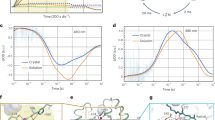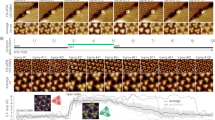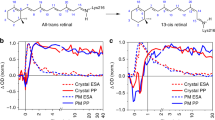Abstract
BACTERIORHODOPSIN (a purple pigment) is a light-driven proton pump1,2, found in patches of the cell membrane of Halo-bacterium halobium3,4, and is chemically similar to the visual pigment rhodopsin of animal eyes4. In both molecules the chromophore retinal is linked as a protonated Schiff base to a lysine residue of the apoprotein opsin1,5,6. Light induces bacteriorhodopsin to move protons from the inside to the outside of the cell. The resulting electrochemical proton gradient across the membrane is finally used to synthesise ATP. We report here the application of a new technique for the direct measurement of small capacitative charge displacements in oriented molecules. Our photoelectric measurements using asymmetrically aligned bacteriorhodopsin demonstrate that this protein undergoes reversible conformational changes after absorption of light.
This is a preview of subscription content, access via your institution
Access options
Subscribe to this journal
Receive 51 print issues and online access
$199.00 per year
only $3.90 per issue
Buy this article
- Purchase on Springer Link
- Instant access to full article PDF
Prices may be subject to local taxes which are calculated during checkout
Similar content being viewed by others
References
Oesterhelt, D., Stoeckenius, W. Proc. natn. Acad. Sci. U.S.A. 70, 2853–2857 (1973).
Stoeckenius, W. Sci. Am. 234, 38–46 (1976).
Oesterhelt, D. & Stoeckenius, W. Nature new Biol. 233, 149–152 (1971).
Blaurock, A. E. & Stoeckenius, W. Nature new Biol. 233, 152–155 (1971).
Lewis, A., Spoonhower, J., Bogomolni, R. A., Lozier, R. H. & Stoeckenius, W. Proc. natn. Acad. Sci. U.S.A. 71, 4462–4466 (1974).
Lewis, A. & Spoonhower, J. in Neutron, X-Ray and Laser Spectroscopy in Biophysics and Chemistry (eds Yips, S. & Chen, S.) (Academic, New York 1974).
Lozier, R. H., Bogomolni, R. A. & Stoeckenius, W. Biophys. J. 15, 955–962 (1975).
Oesterhelt, D. Angewandte Chemie 15, 17–24 (1976).
Slifkin, A. M. & Caplan, S. R. Nature 253, 56–58 (1975).
Cone, R. A. & Pack, W. L. in Handbook of Sensory Physiology 1 (ed. Loewen-stein, W. R.) 345–365 (Springer, Heidelberg, 1971).
Rüppel, H. & Hagins, W. A. in Biochemistry and Physiology of Visual Pigments (ed. Langer, H.) 257–261 (Springer, Heidelberg, 1973).
Trissl, H.-W., Darszon, A. & Montal, M. Proc. natn. Acad. Sci. U.S.A. 74, 207–210 (1977).
Henderson, R., & Unwin, P. N. T. Nature 251, 28–32 (1975).
Oesterhelt, D. & Stoeckenius, W. Methods Enzym. 31, 667–678 (1974).
Author information
Authors and Affiliations
Rights and permissions
About this article
Cite this article
TRISSL, HW., MONTAL, M. Electrical demonstration of rapid light-induced conformational changes in bacteriorhodopsin. Nature 266, 655–657 (1977). https://doi.org/10.1038/266655a0
Received:
Accepted:
Issue Date:
DOI: https://doi.org/10.1038/266655a0
This article is cited by
-
Photocurrent generation based on a light-driven proton pump in an artificial liquid membrane
Nature Chemistry (2014)
-
Light-induced conductivity changes of purple membrane suspensions in strong electrolytes
Journal of Bioenergetics and Biomembranes (1988)
Comments
By submitting a comment you agree to abide by our Terms and Community Guidelines. If you find something abusive or that does not comply with our terms or guidelines please flag it as inappropriate.



